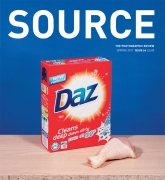Photography and Love
All My Lovin’ – Peggy Sue Amison, Krzysztof Candrowicz, Christoph Tannert – Crawford Art Gallery 27th January - 19th March 2011
Review by Matt Packer
Issue 66 Spring 2011
View Contents ▸
With it’s focus on ‘love, family, and relationships’, All My Lovin’ was an ambitious exhibition in both scale and proposition, seemingly unintimidated by themes so blindingly universal and perennial.
Organised across two floors of the Crawford Art Gallery, the exhibition spaces were punctuated with video rooms, temporary wall constructions, and a reading table. The work itself was installed in a variety of irregular clusters and wall configurations – all perhaps a subtle nod to Edward Steichen’s 1955 exhibition Family of Man that dealt, along similar thematic lines, with extravagant scenography. First Tears Over Another Man, 2002 - Elinor Carucci
First Tears Over Another Man, 2002 - Elinor Carucci
The exhibition was more specific in its thematic treatments than its synopsis might suggest. For one thing, the great majority of the work in All My Lovin’ was produced in the last 10 years, secondly, most of the work pitched from a broadly Western and first-world perspective. Yet the exhibition was clearly well-researched and pulled together a group of photographers and artists that had enough communality and differences between them to make it both cohesive and convincingly diverse. This, perhaps, owed something to the fact that the exhibition was a collaborative affair; curated by Peggy Sue Amison, Krzysztof Candrowicz, and Christoph Tannert, representing various institutional alliances in Ireland, Poland, and Germany respectively.
Much of the work in the exhibition was keen to subvert the ideals and desires of familial normality, which at the same time served as a core reference throughout. Varena Jaekel’s New Family Portraits, played upon the discrepancy between the traditions of formal family portraits and the shift in the very concept of ‘family’ that now embraces same sex parenting and gay adoption. In these works, the power of traditional photographic representation stubbornly persists despite the groundswell of social and cultural change that has taken place in recent decades. Velbert, 07.02.2006 - Verena Jaekel
Velbert, 07.02.2006 - Verena Jaekel
Also exploring family, this time their own, were works by Doug Dubois, Carolle Benitah and Edith Maybin, among others. From Doug Dubois’ lyrical portraits and semi-staged scenarios of his parents and siblings in All the Days and Nights, through to Carolle Benitah’s Just The Two of Us – an ongoing typology of self-portraits with her son – ‘family’ in these cases served less like a remote subject and more as a process through which human relationships were negotiated, represented, and negotiated again.
If All My Lovin’ set out to emphasise photographers’ choices in addressing the themes of the exhibition, it also drew in questions of photography’s constraints. Thus, Elinor Carucci’s series of works, Crisis – "taken during a very difficult time in my relationship with my husband", as Carucci herself describes the works – approaches the said ‘crisis’ with a stylistic self-awareness that ultimately felt more restrictive than exploratory and enquiring. So too Lucia Strán˘aiová’s Grand Parents series that are both committed to documenting the artist’s elderly relations, and formal exercises in disfigurement. San Francisco, 23.04.2006 - Verena Jaekel
San Francisco, 23.04.2006 - Verena Jaekel
Yet this same difficulty, between photographic form and subjective treatment, took surprising and interesting turns elsewhere in the exhibition, particularly in works by Phil Toledano, Muireann Brady, and Anna Shteynshleyger. Toledano’s Days with my Father, a series that explored the artist’s relationship with his dying father, consisted of photographic works and accompanying texts that narrated the final moments of their being together. Toledano’s works not only particularise the act of photography as a mode of intimate encounter, but also suggest a kind of visual impasse: that the text in some way replaces a communication that the photographs cannot, or best not, commit.
Though less tragic in subject, Muireann Brady’s Rituals Interrupted operated similarly to Toledano’s series in setting up a reading between text and image. Brady’s series was presented as diptychs of hand-written Post-It notes – the instructions of an itinerant parent for children part-trusted with the job of looking after themselves – combined with photographs of absent domestic interiors that were visual analogues of these instructions. Brady’s photographs were taken during a period in which the artist returned to living at home with parents that had got long used to the absence of their children. from Rituals Interrupted - Muireann Brady
from Rituals Interrupted - Muireann Brady from Rituals Interrupted - Muireann Brady
from Rituals Interrupted - Muireann Brady
In Anna Shteynshleyger’s Conversation, the relationship between text and image was taken to further extremes in a video that bears no image other than a run of subtitles. These are a composite of transcribed phone conversations between the artist and her divorced parents on separate occasions. Shteynshleyger positions herself as a creative mediator between her parents that no longer talk to each other directly, editing and manipulating the conversations to resemble a two-way dialogue. In the context of All My Lovin’, a photography-based exhibition, the decision to include a work that carries no visual image other than text, has to be taken seriously. In Shteynshleyger’s video work what we view is an image subtracted, rather than simply unapparent. A zero, in other words, that also allows fictional layers and dramatic possibilities of resolution.
Rather than affirm or essentialise photography’s regard for the themes of love, family and relationships, to its credit All My Lovin’ chose a more difficult path in problematising photography’s capacities of address. It was this aspect of the exhibition that provided the exhibition with its critical potential and a new proposition for age-old themes.
Other articles by Matt Packer:






